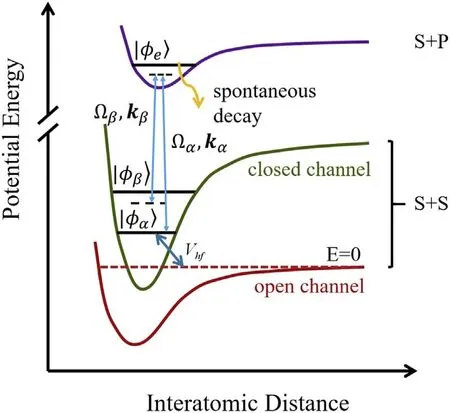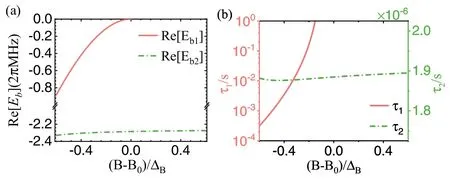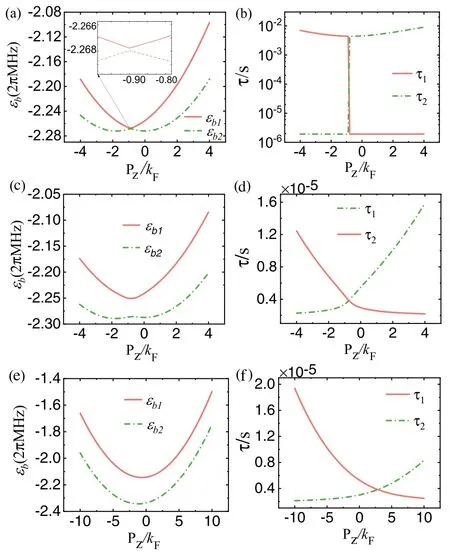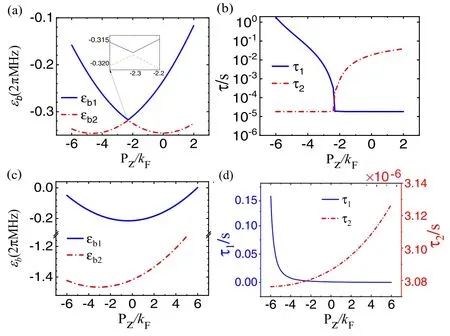Two-component dimers of ultracold atoms with center-of-mass-momentum dependent interactions
Yaru Liu ,Shu Yang and Peng Zhang,?
1 Department of Physics,Renmin University of China,Beijing 100872,China
2 Graduate School of China Academy of Engineering Physics,Beijing 100193,China
3 Key Laboratory of Quantum State Construction and Manipulation (Ministry of Education),Renmin University of China,Beijing 100872,China
Abstract In a previous paper[Phys.Rev.A 95,060 701(R)(2017)],we demonstrated that a new type of twobody interaction,which depends on the center of mass (CoM) momentum,can be realized for ultracold atoms via laser-modulated magnetic Feshbach resonance(MFR).Further studies(e.g.L He et al,Phys.Rev.Lett.120,045 302(2018))show that various interesting phenomena,such as Fulde–Ferrell superfluids,can be induced by scattering between ultracold atoms with this interaction.In this work we investigate the shallow bound states of two ultracold atoms with this type of interaction.We show that when the magnetic field B is below the MFR point B0,two shallow bound states can appear in this system.Namely,a ‘two-component dimer’ or a dimer with pseudo-spin 1/2 can be formed by two atoms.Furthermore,the dispersion curve of the dimer may have either single or double minimums in the CoM momentum space.The latter case can be explained as a result from significant pseudo-spin-orbital coupling(SOC)effects.Our results show that the ultracold gases with CoM momentum dependent interaction may be a candidate for quantum simulations with ultracold two-component molecules,especially the molecule gases with SOC.
Keywords: center-of-mass-momentum dependent interaction,Raman-laser modulated MFR,two-component dimer
1.Introduction
In recent decades,ultracold atom gases are used as a wonderful platform for quantum simulations of few-body and many-body physics [1–4].Thanks to their high degree of tunability,ultracold gases can be used not only to realize the important models of quantum physics,such as the Bose and Fermi Hubbard models [5–9],but also to prepare interesting novel quantum systems which have not been observed or studied in other natural systems,such as momentum space lattices [10] and the four-dimensional Hall system [11–13].The realization of these system extended the research area of quantum physics.
In 2017,J Jie and one of the authors (PZ) demonstrated that by using the technique of laser modulated magnetic Feshbach resonance (MFR) [14–16],one can realize a new type of pairwise interaction,which depends on the two-body center-of-mass(CoM)momentumP,between ultracold atoms[17].Explicitly,the two-atom scattering lengtha(P) is a function ofP,the dispersion relation of each single atom is stillp2/(2m),withpandmbeing the one atom momentum and mass,respectively.This CoM momentum dependent interaction (CoMMDI) is novel because for almost all natural systems the two-body interactions are independent of the CoM momentum.Further research shows various phenomena,such as Fulde–Ferrell superfluids and synthesis of majorana mass terms,may be realized via ultracold gases with this interaction [18–23].Nevertheless,so far the studies are mainly focused on the many-body effects induced by atomic scattering,and the bound states of this system have not been studied systemically.
In this paper we investigate bound states of two ultracold atoms with a CoMMDI for various parameter regions.We find thatB The remainder of this paper is organized as follows.In section 2,we introduce our system in detail and show the approach to calculate the energy and lifetime of the two-body bound states.Our results are shown and discussed in section 3.In section 4,there is a brief summary. As in [17],we consider two ultracold Fermi atoms with interaction in electronic ground states(S states).As shown in figure 1,we assume that the system is near an MFR.Furthermore,the closed-channel bound state|φα〉of this MFR is effectively coupled to another bound state |φβ〉 of the same channel.This coupling is induced by two Raman beams α and β propagating in different directions,which directly couples |φα〉 and |φβ〉 to a bound state |φe〉 in an excited channel,i.e.the ‘S+P’ channel with one atom being in the electronic excited state (the P-state),respectively. The Hamiltonian of our system is given by whereP(p) is the CoM (relative) momentum of the two atoms,Ris the CoM coordinate,M(μ) is the total (reduced)mass,Ej(j=α,β,e)is the energy of the bound state |φj〉,and Ωl(l=α,β)is the Rabi frequency of the Raman-laserl,with corresponding angular frequency ωland the wave vector iskl.In addition,the termHMFRin equation (1) is defined as whereris the relative coordinate of the two atoms,andVbgis the background potential energy of the open channel of the MFR. Figure 1.A schematic picture of the Raman-laser modulated MFR. In this work we calculate the bound state of these two atoms.As shown in[17],it is convenient to do the calculation in the rotated frame induced by a unitary transformation U: The transformed Hamiltonian isHrot=UHU?,which can be written as: where theP-dependent one-photon and two-photon detunings Δ1p(P) and Δ2p(P) are defined as As proved in our previous work[17],for our system,the energy of a two-atom bound state with CoM momentumPcan be expressed as whereEb(P) is the ‘CoM-momentum-dependent dimer energy’.We can deriveEb(P) by solving the equation: Here Σ(Eb,P) is the self-energy matrix,and is given by whereE′αand γ are the Lamb shift and the spontaneous decay rate of |φe〉,and satisfyEα+E′α=δμB(B-B0),with δμBbeing the magnetic moment difference between the channelsOandCandB0being the resonance position.In addition,the function χ(E) in equation (9) is defined as whereabgand ΔBare the background scattering length and width of the MFR,respectively. In this work,we deriveEb(P) for ultracold40K or6Li atoms,by numerically solving equation (8) under the conditions Re[Eb] <0and Im[Eb] <0.The binding energy of the bound state is ∣Re[Eb(P)]∣,and the lifetime τ of the bound state is given by Notice that the expression(9)of the self-energy matrix Σ(E,P)is not applicable when Re[∣Eb∣]is comparable or larger than the van der Waals energy of the system(of the order of(2π)10 MHz and(2π)100 MHz for K and Li atoms,respectively).Thus,in the following calculations we ignore the ‘unphysical’ solutions of equation (8) with Re[∣Eb∣] >(2π)10MHz.In our calculations for the40K or6Li atoms,for each group of parameters we always find that there are two and one shallow dimers forB In this section,we show the energy and lifetime of dimers given by our calculations,for ultracold40K or6Li atoms,and investigate the dispersion relation of these dimers for various laser beams and magnetic fields. We first study the bound state of two ultracold40K atoms in the lowest two hyperfine states |F=9/2,mF=-9/2〉 and|F=9/2,mF=-7/2〉,respectively.As in[17],we consider the cases of the Raman-laser modulated MFR withB0=202.2 Gauss (G),ΔB=8G,abg=174a0,and δμB=1.68μB,witha0and μBbeing the Bohr’s radius and Bohr’s magneton,respectively. In figure 2,we show the energy Re[Eb] and lifetime of the shallow bound states,as functions of the magnetic field,for the cases with typical parameters of Raman lasers and fixed CoM momentumP=0.It is shown that,as mentioned above,forB Figure 2. The dimer energy Re[Eb] (a) and lifetime τ (b) of bound states of two 40K atoms with CoM momentum P=0,Ωα=(2π)10 MHz,Ωβ=(2π)30 MHz,=(2π)400 MHz,=-(2π)2.1×104Hz,γ=(2π)30 MHz,ωα ≈ωβ=(2π)3.9×1014 Hz,and kα=-kβ.Other parameters are shown in the main text. Figure 3. The dispersion relation ?b(Pz)≡+Re[Eb(Pzez)] and lifetime of bound states of two ultracold 40K atoms with B In figure 3 we illustrate the dispersion relation and lifetime of the bound states of two40K atoms,for three groups of typical parameters withB Furthermore,the effect of the Raman beams is significant when |kα-kβ| is large.Due to this fact,we consider the case where the Raman beam α(β)is being propagating along thez-(-z-)direction,so that the value of |kα-kβ| is maximum for fixed frequencies of the Raman beam.When the Raman beams are not propagating along opposite directions,the results would be quantitatively different because the effect of the Raman beams would be weaker. As shown in figure 3,the dispersion curve of the two bound states depends on the parameters of the Raman lasers.Since the two bound states can be understood as two internal states of a single dimer (molecule),this result implies that an SOC of the molecule is induced by the Raman-laser beams applied to modulate the MFR.Explicitly,in the case of figure 3(a)and(b),the dispersion curve of the two bound states are shifted parabolic curves with an avoided crossing.These dispersion curves are very similar to the ones of a single two-component ultracold atom with a synthetic one-dimensional SOC,which is induced by two Raman beams with relatively small Rabi frequency [24].In addition,in the case of figure 3(c-f),there is no avoided crossing between the dispersion curve of the two bound states,which are similar to the ones of ultracold atoms with SOC generated by strong Raman beams with large Rabi frequency.Therefore,our system may be used to realize ultracold gases of molecules with various types of SOC. Now we consider the bound states of two ultracold6Li atoms in the lowest two hyperfine states |F=1/2,mF=1/2〉 and |F=1/2,mF=-1/2〉,respectively.We focus on the cases of the Raman-laser modulated MFR withB0=543.25 Gauss(G),ΔB=0.1G,abg=60a0,and δμB=2μB,which is much narrower than the above one of40K atoms.The Raman modulation of this MFR has been studied experimentally [25]. As in the above subsection,in figure 4 we illustrate the dimer energy Re[Eb]and lifetime τ as functions of the magnetic field for a typical case.Similar to the systems of40K atoms,there are two and one shallow bound states forB Figure 4. The dimer energy Re[Eb] (a) and lifetime τ (b) of bound states of two 6Li atoms with CoM momentum P=0,Ωα=(2π)10 MHz,Ωβ=(2π)30 MHz,=(2 π)400 MHz,=0 Hz,ωα≈ωβ=(2π)×3.9×1014 Hz,γ=2π×30 MHz,and kα=-kβ.Other parameters are shown in the main text. Figure 5. The dispersion relation ?b(Pz)≡+Re[Eb(Pzez)] and lifetime of bound states of two ultracold 6Li atoms with B In this work we calculate the energy and lifetime of the bound states of two ultracold atoms under a Raman-laser modulated MFR proposed in [17].The results for ultracold6Li and40K atoms are investigated in detail.Our results show that forB However,it should be noticed that for the systems of6Li and40K atoms studied above,the bound state lifetime is as short as μs in many cases.This fact,which is due to the large spontaneous decay rate γ,may strongly restrict the application of these bound states.One possible approach to solve this problem is to use MFR between an alkaline atom and an alkaline-earth (like) atom in the1S0state [26],and modulate this MFR with Raman beams coupling the atoms to an excited bound state with the alkaline-earth(like)atom being in the3P1state.Since the linewidth of the3P1state is only of the order of kHz,the spontaneous decay rate of this excited bound state may be much shorter than one of the two alkaline atoms. Acknowledgments This work was supported by the National Key Research and Development Program of China(Grant No.2022YFA1405300),the National Safety Academic Fund(Grant No.U1930201),the Fundamental Research Funds for the Central Universities,and the Research Funds of Renmin University of China(22XNH100).2.Calculation of the bound state energy

3.Results and analysis
3.1.Ultracold 40K atoms


3.2.Ultracold 6Li atoms


4.Summary and discussion
 Communications in Theoretical Physics2024年4期
Communications in Theoretical Physics2024年4期
